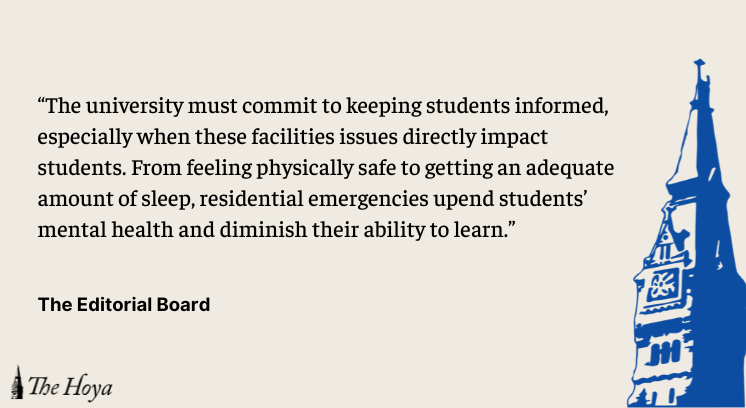Georgetown University is aflame with facilities failures.
The Editorial Board calls on administration to get ahead of these concerns before they create further issues to the detriment of students.
In the early hours of Sept. 28, the loud blaring of a fire alarm abruptly awakened residents of LXR residence hall. Although there was no actual fire, this was no ordinary drill.
Water intrusion issues at 12 a.m. triggered the fire alarm, and its ringing lasted for over five hours until it was finally shut off at 5:10 a.m.
Students like Julio Wang (SFS ’25) were left distraught and sleep-deprived by this late-night disturbance.
“I stayed in Lau until 4 a.m., during which I was unable to be productive because I was very sleepy,” Wang wrote to The Hoya. “I was unable to go to my 11 a.m. lecture in the morning because I was too tired, and I woke up at 3 p.m. that day.”
This unfortunate event exposed the university’s failure to be proactive in safety equipment maintenance.
A university spokesperson acknowledged that much of the equipment was not functional.
“While investigating the incident at LXR, we discovered a number of disabled, damaged or destroyed fire alarm devices in student rooms,” a university spokesperson wrote to The Hoya. “Disabling the fire alarm system puts students at risk. Additionally, these devices can cost hundreds of dollars and be difficult to replace in a timely fashion.”
Specifically, the Board urges Georgetown to conduct a comprehensive evaluation of all campus safety equipment, particularly fire alarms, which have proven to be a constant issue throughout the semester.
Later that same day, shortly before 8 p.m. in Copley Hall, an overloaded dryer caught fire. However, residents were unaware of the active fire for 20 minutes, as the alarm only went off at 8:20 p.m., according to residents. The alarm continued for another two hours, even though students were permitted to re-enter the building at 8:35 p.m.
No students were injured, but this failure in emergency notification is unacceptable.
In addition, on the morning of Oct. 9, the prolonged ringing of the fire alarm in Pedro Arrupe, S.J., Hall startled sleeping students at 7:43 a.m.
Residents, like Frances Ross (CAS ’26), were disappointed with the amount of time it took for the alarm to be deactivated.
“My roommate and I came outside, and after waiting for a while, we eventually went to Epi’s to sit down and have breakfast. Even by the time we came back, the fire alarm was still going,” said Ross to The Hoya.
The following day, Oct. 10, at around 10:30 a.m., Village C East executed its scheduled fire alarm. However, on the second floor, no sound accompanied the hallway’s flashing lights. As a result, students in their rooms did not evacuate. If there had been an actual fire, students would be in serious danger.
Given these events, the Editorial Board condemns the administration’s negligence regarding fire safety, as not repairing the alarms actively endangers students.
To be clear, the Board does not fault facilities management staff for these fire alarm issues. The Georgetown administration is ultimately responsible for ensuring that workers can adequately and quickly respond to emergencies.
The university has acknowledged its shortcomings in facilities staff training, specifically regarding emergency response, and this must be made a greater priority.
“We are working to provide training to late shift staff and managers on how to approach and mitigate such incidents in the future to decrease the duration of the alarms,” a university spokesperson wrote.
In addition, increased night-time staff would allow for greater, more efficient responses to late-night residential problems. There is no reason that the fire alarm in LXR should have lasted for more than five hours.
Moreover, the administration must improve communication between itself and affected residents. Students deserve to know the status of their living spaces and cannot be left in the dark.
Samuel Bailey (SFS ’26) said the university’s messaging during the LXR fire alarms was non-existent.
“It took GUPD close to 15 minutes to get there after the alarm started,” Bailey wrote to The Hoya. “They didn’t give us any updates while all of this was happening, so we had no idea how long it would take before we could go back inside.”
The university must commit to keeping students informed, especially when these facilities issues directly impact students. From feeling physically safe to getting an adequate amount of sleep, residential emergencies upend students’ mental health and diminish their ability to learn.
The Editorial Board insists that Georgetown take a proactive stance on fire safety. It is the university’s obligation to ensure that all emergency equipment is functional, all staff are prepared for late-night events and that students are informed.
It is time to put out the facilities fire.
The Hoya’s Editorial Board is composed of six students and is chaired by the opinion editors. Editorials reflect only the beliefs of a majority of the board and are not representative of The Hoya or any individual member of the board.














